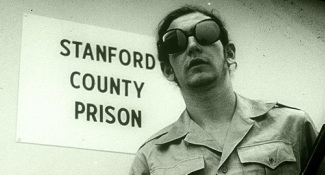 A Stanford student playing the part of a guard. A Stanford student playing the part of a guard. Tags: crime/law/deviance, psychology/social psychology, broken windows theory, labeling theory, research ethics, social experiment, 21 to 60 mins Year: 1992 Length: 29:00 Access: YouTube Summary: In 1971, psychologist Philip Zimbardo set out to discover whether good people can do evil things if placed within particular social contexts. To examine this, he and his colleagues transformed the basement of Stanford University's Psychology Department into a makeshift prison, recruiting local college students to play the roles of prison guards and prisoners. This social experiment would later become known for its controversial nature, testing the ethical boundaries of social scientific research on human subjects. These clips are from the 1992 documentary film, Quiet Rage, which features original footage of the experiment along with follow-up interviews with research subjects (full documentary available online here). The documentary is excellent for teaching concepts central to the field of deviance and social control, including broken windows theory and labeling theory, as well as other core sociological concepts such as norms, roles, social expectations, and research ethics. This documentary was written by Zimbardo and directed and produced by Ken Musen. The Stanford Prison Experiment website features additional information and resources. I would like to thank Audrey Sprenger for suggesting this clip. Submitted By: Valerie Chepp
5 Comments
Dan Douglas
2/12/2014 09:22:27 pm
Change the links to the 3 parts
Reply
Manuel Franco
7/30/2023 11:59:53 am
I just want to say Thank You to everyone who supported me through the years. My name is Manuel Franco, New Berlin, Wisconsin. My story of how I won the Powerball lottery of $768.4M is a bit of a tale. I have been playing Powerball tickets for 6 years now since I turned 18. I bought my first ticket on my 18 birthday. I was feeling very lucky that day because I had contacted Dr. Odunga Michael to help me with the winning Powerball numbers. I really had that great great feeling that I looked at the camera wanting to wink at it. I only did a tiny part of it and trusted him. He gave me the numbers after I played a couple other tickets along with it for $10. I checked my ticket after the winnings came online and saw the numbers were correct including the Power play. I screamed for about 10 minutes because it felt like a dream. I had won $768.4M. You can check my winning testimony with the lottery officials just with my name search. Thank you Dr Odunga. Well, his email is [email protected] and you can also call or Whats-app him at +2348167159012 so you guys can contact him
Reply
mark hold
7/8/2024 07:47:25 am
Herbal Penis Enlargement product is 100% guaranteed to Enlarge and get a better ERECTION, the reason why most people are finding it difficult to enlarge Penis is that they believe in medical reports, drugs and medical treatment which is not helpful for Penis Enlargement. Natural roots/herbs are the best remedies which can easily Enlarge your Penis permanently Contact Dr MOSES BUBA via Email: [email protected] or via WhatsApp: +2349060529305. for Natural root and herbal remedies put together to help Enlarge manhood and Erect healthily. I also learn that Dr MOSES BUBA also can cure other types of diseases, HEPATITIS B,DIABETICS,CANCER,HPV,LOW SPERM CAM, HIV/STDS, FIBROSIS LOST OF WEIGHT, BREAST ENLARGEMENT, HIPS and BUMS ENLARGEMENT etc .
Reply
Leave a Reply. |
Tags
All
.
Got any videos?
Are you finding useful videos for your classes? Do you have good videos you use in your own classes? Please consider submitting your videos here and helping us build our database!
|
 RSS Feed
RSS Feed
